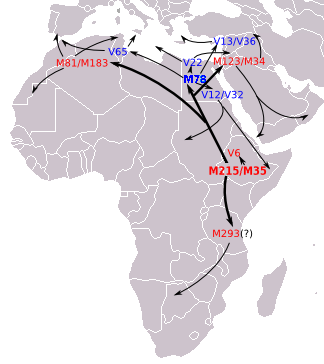That map is not Correct about Greece cyprus and minor asia
check the numerals in peloponese,
the diversity is bigger in peloponese and the % equal,
historically there are many connections with messenians to be E-V13
in fact the cut Albanian tribes like arberesh have very low E-V13
E-V13 is connected with copper times and migration from cyprus,
Cyprus has also high E-13
According Cruciani et al, 2007 a possible time of arrival E carriers to the Balkans is between 4000 and 4700 year ago. It is 2000 to 2700 years BC.
Trombetta et al after rigorous scientific testing brought up a theory that E carriers in the Balkans arrived by sea
http://dirkschweitzer.net/E3b-papers/MolecularBiologyandEvolution-07-24-6-1300.pdf
http://mbe.oxfordjournals.org/content/24/6/1300.full.pdf+html
2007
Oxford University Press
“By analyzing a worldwide sample of 6,501 male subjects, wehave identified 517 chromosomes belonging to haplogroup E-M78, more than twice the number found in a previous study (Cruciani et al. 2004). These chromosomes have been further analyzed for the biallelic markers M148 (Underhill et al. 2000), M224 (Underhill et al. 2001), V12, V13, V19, V22, V27, V32 (Cruciani et al. 2006), V36, and V65 (present study).... Four subhaplogroups were either rare(1 and 2 subjects for E-V27 and E-V19, respectively) or absent(E-M148andE-M224)in the global sample, whereas theother haplogroups/paragroups were relatively common (table1 and fig. 2).”
You can see that subhaplogroups of E-M78 are (excluding those that are very rare):
E-V12
E-V32
E-V13
E-78*
E-V65 and
E-V22.
“In conclusion, the peripheral geographic distribution of the most derived subhaplogroups with respect to northeastern Africa, as well as the results of quantitative analysis of UEP and microsatellite diversity are strongly suggestive of a northeastern rather than an eastern African origin of E-M78. Northeastern Africa thus seems to be the place from where E-M78 chromosomes started to disperse to other African regions and outside Africa.”
Another strange but interesting is that,
http://mathildasanthropologyblog.wordpress.com/2008/05/02/eurasian-origins-of-the-berbers/
Also
E1b1b1a (E-V68)
Main article:
E1b1b1a
E1b1b1a (E-V68), is dominated by its longer-known sub-clade E-M78 (E1b1b1a1). Three "E-V68*" individuals who are in E-V68 but not E-M78 have been reported in Sardinia, by
Trombetta et al. (2011), when announcing its discovery. The authors noted that because E-V68* was not found in the Middle Eastern samples, this appears to be evidence of maritime migration from Africa to southwestern Europe.
E1b1b1a1 (E-M78) is a commonly occurring sub-clade, widely distributed in
North Africa, the
Horn of Africa,
West Asia, (the Middle East and Near East) "up to Southern Asia",
[1] and all of
Europe.
[22] The European distribution has a frequency peak centered in parts of the
Balkans (up to almost 50% in some areas)
[3][23]) and Italy, and declining frequencies evident toward western, central, and northeastern Europe.
Based on genetic
STR variance data, Cruciani et al. (2007) suggests that E1b1b1a1 originated in "Northeastern Africa", which in their study refers specifically to
Egypt and
Libya.
[Note 4] about 18,600 years ago (17,300 - 20,000 years ago).
[Note 5] Battaglia et al. (2008) describe Egypt as "a hub for the distribution of the various geographically localized M78-related sub-clades" and, based on archaeological data, they propose that the point of origin of E-M78 (as opposed to later dispersals from Egypt) may have been in a
refugium which "existed on the border of present-day
Sudan and Egypt, near
Lake Nubia, until the onset of a humid phase around 8500 BC. The northward-moving rainfall belts during this period could have also spurred a rapid migration of
Mesolithic foragers northwards in Africa, the
Levant and ultimately onwards to
Asia Minor and Europe, where they each eventually differentiated into their regionally distinctive branches". Towards the south,
Hassan et al. (2008) also explain evidence that some subclades of E-M78, specifically E-V12 and E-22, "might have been brought to Sudan from North Africa after the progressive desertification of the Sahara around 6,000-8,000 years ago".
[edit] Sub Clades of E1b1b1a1 (E-M78)
There are four recognized sub-clades, which were mostly defined by
Cruciani et al. (2006).
- E1b1b1a1a (E-V12). Found in Egypt, Sudan, and other places. Has an important sub-clade E1b1b1a1a2 (E-V32) which is very common amongst Ethiopian Oromo, Borana Oromo from Kenya and Somalis.
- E1b1b1a1b (E-V13). This is the most common type of E1b1b found in Europe and is especially common in the Balkans.
- E1b1b1a1c (E-V22). Found in Egypt, the Middle East and other places.
- E1b1b1a1d (E-V65). Associated with the Maghreb, but also found in Italy and Spain.
- E1b1b1a1e (E-M521). Found in two individuals in Greece by Battaglia et al. (2008)
the E-V13 is cypriotic-Levantine,
the map you show is incorrect, in peloponese exist also a 44% E-V13 and in cyprus total 27% while in some local reach >50%
you can read dienekes about E-V13 in the balkans,
http://dienekes.blogspot.com/2008/07/expansion-of-e-v13-explained.html
and cut albanian tribes.
http://dienekes.blogspot.com/2010/07/y-chromosomes-of-arbereshe-from.html


